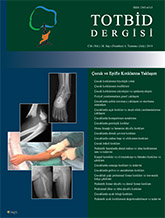
Ankle fractures and physeal injuries in children are of particular importance as they are the second most common injuries. Since growth plates that are open in the growing child are relatively weaker than the bones and ligaments around it, injuries cause more physeal damage and fractures. Pain and sensitivity on the physis in physical examination is an important finding in the diagnosis of ankle fractures. In addition, swelling, ecchymosis and deformity in the injury should also be noted. Although direct radiography is an important diagnostic tool, computed tomography can determine the amount of dissociation especially in intra-articular fractures, and may be necessary in surgical planning. The Salter-Harris classification is widely used as a good guide in planning appropriate treatment and for long-term prognosis. Casting may be an effective method in unstable ankle fractures but requires a strict radiological monitoring. In cases where closed reduction cannot be achieved with Salter-Harris type III and IV fractures (Tillaux and three plans fracture), open reduction and fixation by K-wires and screws are necessary if the intra-articular step is greater than 2 mm. The complications that may develop as a result of physis injury may be independent of the treatment method. Therefore, close follow-up is necessary for at least one year after injury due to the risk of development of shortening and/or angular deformities as a result of growth arrest in ankle physeal injuries in young children.